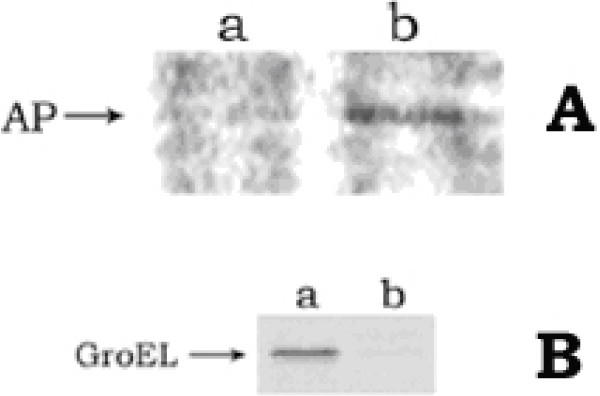Figure 7.
A. Formation of AP-DnaK binary complex in CCCP-treated cells. Log phase cells, in phosphate-free MOPS medium, were labeled with 35S-methionine (30 μCi/ml) for 30 min at 30°C in presence of 50 μM CCCP. 1 ml labeled cells was chilled, centrifuged and resuspended in 200 μl Tris buffer (30 mM, pH 8.0) containing 20% sucrose, 10 mM EDTA (pH 8.0), 1 mg/ml lysozyme and the cell suspension was kept at 4°C for 10 min. 1 ml lysis solution [50 mM Tris (pH 8.0), 40 mM NaCl and 0.1% Tween 20] was added to the cell suspension and placed on ice for 30 min; NaCl was then added to a final concentration of 0.2 M and the cell lysate was centrifuged at 10,000 rpm for 10 min at 4°C. The supernatant was first immunoprecipitated with anti-DnaK antibody. The immunocomplex was washed with above lysis solution containing 0.2 M NaCl, suspended in 100 μl Tris (pH 7.4), heated at 100°C for 3 min and finally immunoprecipitated with anti-AP antibody. The immunoprecipitate was run in 12% SDS-polyacrylamide gel and finally phosphorimaged. Lane a: CCCP-treated cell; lane b: control cell. B. State of GroEL induction in cells containing excess DnaK. Transformed cells were primarily grown up to log phase (~1.5 × 108 cells/ml) at 30°C in MOPS medium. 1 mM IPTG was then added and growth was allowed for another 30 min (to induce DnaK). The cells were transferred to methionine-free MOPS medium, grown further in presence of 50 μM CCCP for 20 min and then labeled with 35S-metthionine (30 μCi/ml) for 10 min. Parallel experiment was done for untransformed cells also. Cell extracts were then prepared by boiling with SDBME buffer. Equal amount of protein extract from both transformed and untransformed cells, as estimated by Bradford method, was subjected to immunoprecipitation using anti-GroEL antibody. The immunoprecipitate was run in SDS-polyacylamide gel and phosphoroimaged. Lane a: untransformed cell; lane b: transformed cell.

